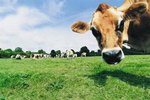
It's easy to understand human uniqueness; however, sometimes it's tempting to think a cow is a cow is a cow. As each person is different, including identical twins, so is each cow. Individuality boils down to genetic makeup and how environment influences development. Phenotype helps you see the differences.
Birth of Phenotype and Genotype
In 1911, Danish scientist Wilhelm Johannsen was studying genetically identical beans and discovered variations among them. He determined the differences were from environmental influences, leading him to develop the idea of genotype and phenotype.
Genotype is an individual organism's genetic makeup. You, your dog, your parakeet, your goldfish and the steak on your plate all have unique genotypes. Genotype is the instructions your body uses to grow and it's the foundation for your genetics, including specific traits, such as hair color.
Phenotype
Phenotype, on the other hand, is how the genotype makes itself known -- the value of the trait. Genotype determines your hair color, but the resulting brunette is the phenotype. Phenotype is the individual's observable characteristics, determined by environmental influences and genetic makeup. In cattle, phenotype can take on qualitative or quantitative properties.
Qualitative Cattle Phenotype
Qualitative traits are usually determined by just one or a few genes, with environment playing a minor role in qualitative phenotypes. Qualitative phenotypes in cattle include blood type, hair color, presence -- or absence -- of horns and defects such as dwarfism.
Quantitative Cattle Phenotype
Quantitative phenotypes are influenced by many pairs of genes and are more strongly influenced by the environment than qualitative traits. Quantitative phenotypes are particularly important to those who raise cattle for profit. Examples include milk production and composition, how efficiently a cow converts her feed to growth and disease resistance. Because the quantitative traits are influenced by environment, they aren't fixed and can change over time.
References
Photo Credits
-
John Foxx/Stockbyte/Getty Images




